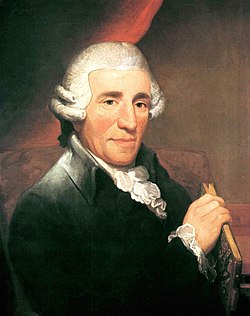
Joseph Haydn's Symphony No. 14 in A major, Hoboken I/14, may have been written between 1761 and 1763. [1]
Symphony No. 14 is scored for 2 oboes, bassoon, 2 horns, strings and continuo. As was becoming more common for Haydn, this symphony has four movements:
- Allegro molto, 3
4 - Andante in D major, 2
4 - Menuetto e Trio: Allegretto, with the Trio in A minor, both 3
4 - Allegro, 6
8
The Andante was originally the finale of an early divertimento "Der Geburtstag" (en. "Birthday"), Hob. II/11. [2] The variations of the divertimento are reworked into sonata form for the symphony.
The trio of the Minuet features an oboe solo accompanied by violins and cello. [2]
The finale is highly contrapuntal [2] and is based on a descending scale. [3]